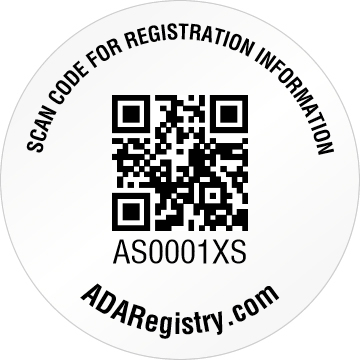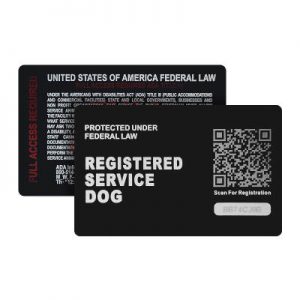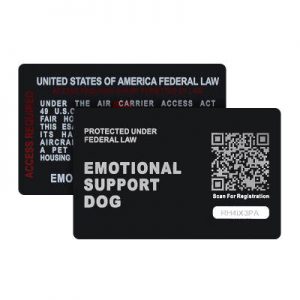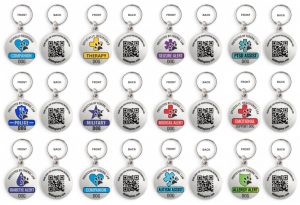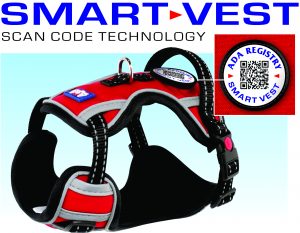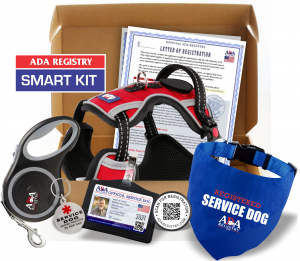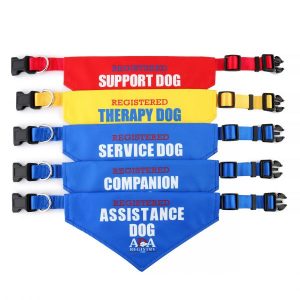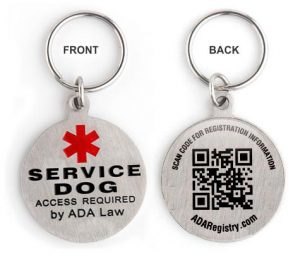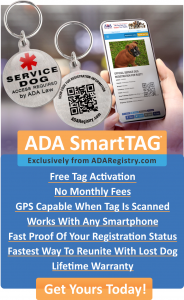Types Of Assistance Dogs
Below are other types of assistance dogs.
Most Common Reasons Listed For Emotional Support Dog Needs.
Stress Related, Adjustment Disorders, Generalized anxiety disorder, Social anxiety disorder, Phobias, Panic disorder, Post-traumatic stress disorder, Separation anxiety, Dissociative Disorders, Factitious Disorders. Eating Disorders, Impulse-Control Disorders, Mental Disorders, Neurocognitive Disorders, Mood Disorders, Neurodevelopmental Disorders, Personality Disorders, Psychotic Disorders, Sexual and Gender Identity Disorders, Sleep Disorders, Somatoform Disorders, Substance Related Disorders, Suicidal Thoughts.
Most Common Reasons Listed For Service Dog Needs.
Arthritis, Ataxia (Poor Balance), Autism, Blindness (or Poor Vision), Cancer, Cardio/ Pulmonary Disease, Cerebral Palsy, Deafness Or Hearing Impared, Diabetes, Medical Alert Needs, Multiple Sclerosis (MS),Pain Related, PTSD, Physical Mobility Issues, Psychiatric Disabilities, Seizure Disorders, Severe Allergy Alert, Spina Bifida, Spinal Cord/Head Trauma, Stroke,
Not Registered Yet?
Emotional Support

An emotional support animal (ESA) or support animal, is a companion animal (pet) that a medical professional says provides some benefit for a person disabled by a mental health condition or emotional disorder. Emotional support animals are typically dogs, but are sometimes cats or other animals.
People who qualify for emotional support animals have verifiable psychological disabilities that substantially interfere with major life activities, such as anxiety disorder, major depressive disorder, or panic attacks.
An emotional support animal differs from a service animal. Service animals are trained to perform specific tasks[1] (such as helping a blind person walk), while emotional support animals receive no specific training. (It therefore stands that in the setting of mental illness, whether or not the animal is a “service animal” vs. an Emotional Support Animal would hinge on whether the dog is formally trained to do something specific to mitigate the mental illness.) Any animal that provides support, well-being, comfort, or aid, to an individual through companionship, non-judgmental positive regard, and affection may be regarded as an emotional support animal.[2]
In the US, disabled people with emotional support animals are exempted from certain rules against having animals in most housing and travel situations. To be afforded protection under United States federal law, the owners of emotional support animals must meet the federal definition of disability and must have a letter from their healthcare providers stating that they are being treated for a disabling condition and that their emotional support animals improve or benefit some component of the disability
Most Common Reasons Listed For Emotional Support Dog Needs.
Stress Related, Adjustment Disorders, Generalized anxiety disorder, Social anxiety disorder, Phobias, Panic disorder, Post-traumatic stress disorder, Separation anxiety, Dissociative Disorders, Factitious Disorders. Eating Disorders, Impulse-Control Disorders, Mental Disorders, Neurocognitive Disorders, Mood Disorders, Neurodevelopmental Disorders, Personality Disorders, Psychotic Disorders, Sexual and Gender Identity Disorders, Sleep Disorders, Somatoform Disorders, Substance Related Disorders, Suicidal Thoughts.
Therapy Dogs

Therapy dogs are dogs that are used to bring comfort and joy to those who are ill or under poor conditions, such as those who have been affected by a natural disaster. Many people are able to connect with dogs and feel the love that they provide, and this has a therapeutic effect on them. Therapy dogs are generally very calm and well-behaved, so that they do not upset or make uncomfortable those around them.
Therapy Dogs
Many people confuse Therapy Animals with Service Dogs. A therapy animal is most commonly a dog (but can be other species) that has been obedience trained and screened for its ability to interact favorably with humans and other animals. The primary purpose of a therapy animal is to provide affection and comfort to people in hospitals, retirement homes, nursing homes, schools, hospices, disaster areas, and to people with learning difficulties.
Therapy animals are privately owned and tend to visit facilities on a regular basis. A therapy animal is only half of the equation, however. A responsible, caring handler is an important member of the therapy animal team. At the end of a visit, therapy animals go home with their owners. Most commonly, therapy animals are dogs that have shown they like people and have the temperament to work with them.
Although therapy animals provide a very important therapeutic service to all kinds of people in need, they are NOT considered “service animals” and they and their handlers have no protections under federal law (ADA, the Fair Housing Act, Air Carrier Access Act, etc.). Some states, however, have laws that afford therapy animals and their handlers rights and protections.
Companion Dogs
Companion animals are those animals who share our homes and lives. Because we consider these animals to be family, because they are family, companion animals enjoy more legal protections than other animals. … Additionally, some cities and counties pass ordinances to protect companion animals.
Service Dog: Medical Alert Dog

Service Dog: Medical Alert Dogs (MADs)
Job: To alert their handler to dangerous physiological changes such as blood pressure, hormone levels or another verifiable, measurable bodily symptom.
Handler: May or may not show signs of disability.
Gear: Depending on the handler’s disability, the dog may or may not have specialized gear.
Public Access Level: Required
Notes: Medical Alert Dogs’ jobs and functions can vary widely. Also, all DADs are Medical Alert Dogs, but not all Medical Alert Dogs are DADs.
Service Dog: Search and Rescue Dog
Service Dog: Search and Rescue Dog
Job: An accelerants detection canine (arson dog) is a dog that has been trained to sniff out minute traces of accelerants that may have been used to start a fire. These dogs go through extensive training before becoming certified accelerates detection canines.
Handler: Trained professional / Firefighter / Inspector
Gear: Required safety gear and official designations. May also carry ID Card to signify Dog as an official working/skilled animal.
Companion Dogs
Companion animals are those animals who share our homes and lives. Because we consider these animals to be family, because they are family, companion animals enjoy more legal protections than other animals. … Additionally, some cities and counties pass ordinances to protect companion animals.
Service Dog: Law Enforcement / Police Dogs

Service Dog: Law Enforcement / Police Dogs (K9)
Job: Specifically trained in a wide range of duties. Their training includes extreme focus, following commands and showing aggression when needed.
Handler: Police and other law enforcement officers, such as: DEA, TSA and SWAT units.
Gear: K9 Officers are equipped with safety gear and other specialized accessories
Notes: Law Enforcement Dogs, K9 officers and other Police dogs play a valuable role in our communities. They serve and protect and should be respected for their excellence.
Service Dog: Military Trained Dogs

Service Dog: Military Trained Dogs
Job: These dogs are trained to obey and assist soldiers in the field or at home to perform tasks, and provide support to our military personnel.
Handler: Military personnel, Bomb and Explosive Experts, Inspectors and Patrol Units
Gear: Military Dogs utilize safety gear, and official ID indication of their service.
Notes: Military Dog’s service and function can vary widely, depending on their training and the capacity of their handler.
Service Dog: Hearing Dogs

Service Dog: Hearing Dogs
Job: To alert their Deaf handler to specifically trained environmental sounds, including, but not limited to, alarms, doorbells, knocking, phones, cars or their name.
Handler: Likely won’t show signs of disability. May or may not speak verbal English.
Gear: Hearing Dogs don’t require special gear, but many state laws designate bright orange as reserved for Hearing Dogs.
Notes: Hearing Dogs can be trained to respond to any environmental sound or cue their handler needs to know about. Just because you can’t see what a Hearing Dog is responding to doesn’t mean he’s not working.
Service Dog: Seizure Alert / Response Dogs

Service Dog: Seizure Alert / Response Dogs
Job: To respond to their handler’s seizures via trained tasks. The dog may retrieve medication, utilize deep pressure stimulation to end a seizure early, fetch a nearby person to help or call 911. Other trained tasks are common as well.
Handler: May or may not show signs of physical disability.
Gear: Typically no special gear required.
Notes: Seizure Alert Dogs fall under this category. Please keep in mind that you cannot train a Seizure Response Dog to alert to seizures — it must be something the dog comes to do naturally via association with their human partner and an intuitive nature.
Service Dog: Physical Assistance Dog

Service Dog: Physical Assistance Dog
Job: A physical assistance dog is a service dog trained to assist a person who has mobility issues, which may include being wheelchair-dependent. Among other tasks such as “providing balance and stability” and “pulling wheelchairs or carrying and picking up things for persons with mobility impairments”, a mobility assistance dog can be trained to open and close doors, and operate light switches, and can “have a major positive impact on the lives of recipients”.[3]
Handler: a physically disabled person who has mobility issues, which may include being wheelchair-dependent
Gear: These dogs usually wear a certain kind of vest so that you can attach a cane like handle. This makes it so that when the dog walks and you hold the handle, the dog will guide you and assist with balance.
Service Dog: Diabetic Alert Dogs

Service Dog: Diabetic Alert Dogs (DADs)
Job: To alert their handler to dangerous or potentially deadly blood sugar highs and lows. Many dogs are trained to call 911 on a special K-9 Alert Phone if their partner cannot be roused.
Handler: May show signs of visible disability, but likely will not. Could be any age from very, very young to a senior citizen.
Gear: Diabetic Alert Dogs typically don’t wear special gear. DADs should carry emergency protocols in their vest if the dog would ever be the first point of contact with an emergency medical team.
Notes: Diabetic Alert Dogs are also known as “Blood Sugar Alert Dogs.”
Service Dog: Fire / Arson Dogs

Service Dog: Fire / Arson Dogs
Job: An accelerate detection canine (arson dog) is a dog that has been trained to sniff out minute traces of accelerates that may have been used to start a fire. These dogs go through extensive training before becoming certified accelerate detection canines.
Handler: Trained professional / Firefighter / Inspector
Gear: Required safety gear and official designations. May also carry ID Card to signify Dog as an official working/skilled animal.
Service Dog: Brace/Mobility Support Dog

Service Dog: Brace/Mobility Support Dogs (BMSD)
Job: A Brace/Mobility Support Dog works to provide bracing or counterbalancing to a partner who has balance issues due to a disability. Many BMSDs also retrieve, open/close doors or do other tasks to assist in day-to-day life or in an emergency.
Handler: Will vary in presentation depending on disability. Could be any age.
Gear: Most Brace/Mobility Support Dogs wear a specially-fitted and designed harness to help them safely assist their partner. However, just because a dog isn’t wearing a brace harness doesn’t mean he may not be a brace dog.
Notes: Brace/Mobility Support Dogs must be large enough to safely support their human partner. In general, BMSD must be at least 23″ tall and 55 pounds to perform brace/counterbalance work safely, and must be proportionally larger if their human is larger than average.
Personal Protection Dogs (Guard Dogs)

Service Dog: Personal Protection Dogs (Guard Dogs)
Job: Specifically trained to protect their handler/owner from harm. Their training includes extreme focus, following commands and showing aggression when needed.
Handler: Person who has concerns about personal safety and safety of property.
Gear: Personal Protection Dogs are equipped with strong harness or leashes to help control them. Studded or specialize collars are sometimes used.
Notes: Although considered dangerous by some, PPDogs, when well trained, pose no additional danger. They are quite loyal to their trainer or handler and only expose forceful nature when in threatening situations.
Service Dog: Severe Allergy Alert Dogs

Service Dog: Severe Allergy Alert Dogs (AADs)
Job: To alert their handler to life-threatening allergens that may be in the area, especially tree nuts, gluten or shellfish
Handler: May or may not have visible signs of disability
Gear: Allergen Alert Dogs typically wear a vest with pockets for emergency information, medical information and/or medication. For their handler’s safety in the event of an emergency and to ensure fast and accurate medical care, AADs should sport a patch that says, “IN EVENT OF EMERGENCY CHECK POCKETS.”
Notes: Often partnered with children, but can be seen partnered with any person with a life-threatening allergy. Most Allergen Alert Dogs carry medical information and emergency protocol in their vest or on a USB key attached to their collar.
Service Dog: Autism Assistance Dog

Service Dog: Autism Assistance Dogs
Job: To assist in calming and grounding an individual on the autism spectrum via tactile or deep pressure stimulation. May also assist in teaching life skills, maintaining boundaries or finding a “runner.”
Handler: Likely to be a child, but could be older. May or may not show visible signs of disability, and may or may not be verbal.
Gear: Autism Assistance Dogs don’t have distinguishing gear. If a dog’s partner is young and non-verbal, the dog should carry emergency protocol and contact information in his vest.
Notes: Autism Assistance Dogs and Sensory Processing Disorder Dogs fall into the same category and usually perform identical task work.
Service Dog: Psychiatric Service Dog

Service Dog: Psychiatric Service Dog
Job: Can vary widely in presentation but often appears to not have a disability. Often cited as having an “invisible” disability.
Handler: a person having mental clarity issues and or psychiatric problems.
Gear: No special gear required.
Notes: Psychiatric Service Dogs are protected under the same federal laws that protect other Service Dogs. They must be given the exact same treatment and access rights. Note: Emotional Support Animals (ESAs) and Therapy Dogs are NOT the same as Psychiatric Service Dogs and are not covered under the ADA, and nor do they have any public access whatsoever.
Service Dog: Wheelchair Assistance Dogs

Service Dog: Wheelchair Assistance Dogs
Job: To assist their partner by retrieving dropped objects, opening doors, retrieving the phone, helping with transfers or anything else their partner may need.
Handler: Is in a wheelchair. May or may not be ambulatory at times.
Gear: No special gear required, but many wear a special harness to assist in pulling a chair or opening a door.
Notes: Wheelchair Assistance Dogs can vary widely in trained tasks and actual job.
Service Dog: Medical Assistance Dogs

Service Dog: Medical Assistance Dogs
Job: To assist their handler with a medical disability via trained, specific, mitigating task work.
Handler: Can vary widely in presentation of disability and age.
Gear: Can vary widely based on dog’s job, function and training.
Notes: “Medical Assistance Dog” tends to be a catch-all category for a Service Dog that doesn’t “fit” anywhere else. It’s also commonly utilized when the handler doesn’t feel like going into detail.
Service Dog: Visual Assistance Dogs

Service Dog: Visual Assistance Dogs
Job: To guide their partially visually impaired or blind handler.
Handler: May or may not show signs of visible disability.
Gear: Visual Assistance Dogs will wear a guide dog harness, typically of which at least some part is white. White is the color protected for use by guide dogs and visually impaired individuals.
Notes: Visual Assistance Dogs are commonly called “Guide Dogs” or “Leader Dogs.” Most are Labs, Golden’s or German Shepherds, but they can be any sturdy, even-tempered, medium or large breed dog.
Service Dog: PTSD MedicalDogs

Service Dog: Medical Alert Dogs (MADs)
Job: To assist their handler and provide support dealing with the emotional and psychological issues related to Post Traumatic Stress Disorder.
Handler: May or may not show signs of disability.
Gear: No specialized gear required but suggested
Public Access Level: Required
Notes: A growing number of veterans, military personnel, law enforcement and other stress related fields are affected each year.
Detection Dogs
Detection dogs have exceptional senses of smell. A detection dog is trained to sniff out a particular substance or group of substances. Common types of substances to be sniffed out include illegal drugs, explosives, blood, human remains, and more. Some detection dogs even learn to detect cancer, certain types of insects (such as bed bugs), or animal feces. They are used in law enforcement, wildlife biology, and in health care.
Most Popular Reasons To Register Your Dog
Most Common Reasons Listed For Emotional Support Dog Needs.
Stress Related, Adjustment Disorders, Generalized anxiety disorder, Social anxiety disorder, Phobias, Panic disorder, Post-traumatic stress disorder, Separation anxiety, Dissociative Disorders, Factitious Disorders. Eating Disorders, Impulse-Control Disorders, Mental Disorders, Neurocognitive Disorders, Mood Disorders, Neurodevelopmental Disorders, Personality Disorders, Psychotic Disorders, Sexual and Gender Identity Disorders, Sleep Disorders, Somatoform Disorders, Substance Related Disorders, Suicidal Thoughts.
Most Common Reasons Listed For Service Dog Needs.
Arthritis, Ataxia (Poor Balance), Autism, Blindness (or Poor Vision), Cancer, Cardio/ Pulmonary Disease, Cerebral Palsy, Deafness Or Hearing Impared, Diabetes, Medical Alert Needs, Multiple Sclerosis (MS),Pain Related, PTSD, Physical Mobility Issues, Psychiatric Disabilities, Seizure Disorders, Severe Allergy Alert, Spina Bifida, Spinal Cord/Head Trauma, Stroke,

